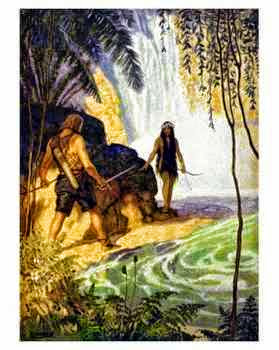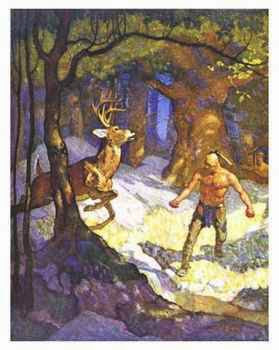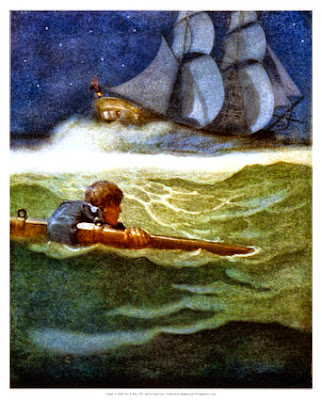Newell Convers Wyeth (October 22, 1882 – October 19, 1945), known as N. C. Wyeth, was an American artist andillustrator. He was the pupil of artist Howard Pyle and became one of America's greatest illustrators. During his lifetime, Wyeth created over 3,000 paintings and illustrated 112 books, 25 of them for Scribner's, the Scribner Classics, which is the work for which he is best known. The first of these, Treasure Island, was one of his masterpieces and the proceeds paid for his studio. Wyeth was a realist painter just as the camera and photography began to compete with his craft. Sometimes seen as melodramatic, his illustrations were designed to be understood quickly. Wyeth, who was both a painter and an illustrator, understood the difference, and said in 1908, "Painting and illustration cannot be mixed-one cannot merge from one into the other."

Early life
N.C. Wyeth was born in Needham, Massachusetts. An ancestor, Nicholas Wyeth, a stonemason, came to Massachusetts from England in 1645. Later ancestors were prominent participants in the French and Indian Wars, the Revolutionary War, the War of 1812, and the American Civil War, passing down rich oral histories and tradition to N.C. Wyeth and his family and providing subject matter for his art, which was deeply felt. His maternal ancestors came from Switzerland, and during his childhood, his mother was acquainted with literary giants Henry David Thoreau and Henry Wadsworth Longfellow. His literary appreciation and artistic talents appear to have come from her.
He was the oldest of four brothers who spent much time hunting, fishing, and enjoying other outdoor pursuits, and doing chores on their farm. His varied youthful activities and his naturally astute sense of observation later aided the authenticity of his illustrations and obviated the need for models: "When I paint a figure on horseback, a man plowing, or a woman buffeted by the wind, I have an acute sense of the muscle strain."
His mother encouraged his early inclination toward art. Wyeth was doing excellent watercolor paintings by the age of twelve. He went to Mechanics Arts School to learn drafting, and then the Massachusetts Normal Arts School and the Eric Pape School of Art to learn illustration, under George Loftus Noyes and Charles W. Reed.
When two of his friends were accepted to Howard Pyle's School of Art in Wilmington, Delaware and Chadds Ford, Pennsylvania, Wyeth was invited to try to join them in 1902. Pyle was the "father" of American illustration, and Wyeth immediately meshed with his methods and ideals. Pyle's approach included excursions to historical sites and impromptu dramas using props and costumes, meant to stimulate imagination, emotion, atmosphere, and the observation of humans in action-all necessities for his style of illustration. Pyle stressed historical accuracy and tinged it with a romantic aura. But where Pyle painted in exquisite detail, Wyeth veered toward looser, quicker strokes and relied on ominous shadows and moody backgrounds. He probably picked up his glazing technique from Pyle. Wyeth's exuberant personality and talent made him a standout student. A robust, powerfully built young man with strangely delicate hands, he ate a lot less than his size implied. He admired great literature, music, and drama, and he enjoyed spirited conversation.
Career
A bucking bronco for the cover of The Saturday Evening Post on February 21, 1903 was Wyeth's first commission as an illustrator. That year he described his work as "true, solid American subjects-nothing foreign about them." It was a spectacular accomplishment for the 20-year-old Wyeth, after just a few months under Pyle's tutelage. In 1904, the same magazine commissioned him to illustrate a Western story, and Pyle urged Wyeth to go West to acquire direct knowledge, much as Zane Grey had done for his Western novels. In Colorado, he worked as a cowboy alongside the professional "punchers", moving cattle and doing ranch chores. He visited the Navajo in Arizona and gained an understanding of Native American culture. When his money was stolen, he worked as a mail carrier, riding between the Two Grey Hills trading post and Fort Defiance, to earn enough to get back home. He wrote home, "The life is wonderful, strange-the fascination of it clutches me like some unseen animal-it seems to whisper, 'Come back, you belong here, this is your real home.'"On a second trip two years later, he collected information on mining and brought home costumes and artifacts, including cowboy and Indian clothing. His early trips to the western United States inspired a period of images of cowboys and Native Americans that dramatized the Old West. His depictions of Native Americans tended to be sympathetic, showing them in harmony with their environment, as demonstrated by In the Crystal Depths (1906). Upon returning to Chadds Ford, he painted a series of farm scenes for Scribner's, finding the landscape less dramatic than that of the West but nonetheless a rich environment for his art: "Everything lies in its subtleties, everything is so gentle and simple, so unaffected." His painting Mowing (1907), not done for illustration, was among his most successful images of rural life. He married Carolyn Bockius of Wilmington and settled in Chadds Ford in 1908 to raise a family on 18 acres (73,000 m2) near the historic Brandywine battlefield. By now he had left Pyle, and commissions were coming in quickly. His hope had been that he would make enough money with his illustrations to be able to afford the luxury of painting what he wanted; but as his family and income grew, he found it difficult to break from illustration.
N.C. Wyeth created a stimulating household for his talented children Andrew Wyeth, Henriette Wyeth Hurd, Carolyn Wyeth, Ann Wyeth McCoy, and Nathaniel C. Wyeth. Wyeth was very sociable, and frequent visitors included F. Scott Fitzgerald, Joseph Hergesheimer, Hugh Walpole, Lillian Gish, and John Gilbert. According to Andrew, who spent the most time with his father on account of his sickly childhood, N.C. was a strict but patient father who did not talk down to his children. His hard work as an illustrator gave his family the financial freedom to follow their own artistic and scientific pursuits. Andrew went on to become one of the foremost American artists of the second half of the 20th century, and both Henriette and Carolyn became artists also; Ann became an artist and composer. Nathaniel became an engineer for DuPont and worked on the team that invented the plastic soda bottle. Henriette and Ann married two of N.C.'s protégés, Peter Hurd and John W. McCoy. N.C. Wyeth is the grandfather of artist Jamie Wyeth and musician Howard Wyeth.By 1911, N.C. Wyeth began to move away from Western subjects and on to illustrating classic literature. He painted a series for an edition of Treasure Island (1911), by Robert Louis Stevenson, thought by many to be his finest group of illustrations. The proceeds from this great success paid for his house and studio. He also illustrated editions of Kidnapped (1913),Robin Hood (1917), The Last of the Mohicans (1919), Robinson Crusoe (1920), Rip Van Winkle (1921), The White Company (1922), and The Yearling (1939). He did work for prominent periodicals, including Century, Harper's Monthly,Ladies' Home Journal, McClure's, Outing, The Popular Magazine, and Scribner's. His early works were sold outright at a handsome price, but only much later did he receive royalties. Wyeth would read a book thoroughly before doing the contracted illustrations, and he specifically created scenes that were thinly described in the book, adding details and mood of his own, as in Old Pew (1911). By 1914, Wyeth loathed the commercialism upon which he became dependent, and for the rest of his life, he battled internally over his capitulation, accusing himself of having "bitched myself with the accursed success in skin-deep pictures and illustrations." He complained of money men "who want to buy me piecemeal" and that "an illustration must be made practical, not only in its dramatic statement, but it must be a thing that will adapt itself to the engravers' and printers' limitations. This fact alone kills that underlying inspiration to create thought. Instead of expressing that inner feeling, you express the outward thought… or imitation of that feeling."
Wyeth also did posters, calendars, and advertisements for clients such as Lucky Strike, Cream of Wheat, and Coca-Cola, as well as paintings of Beethoven, Wagner, and Liszt for Steinway & Sons. He painted murals of historical and allegorical subjects for the Federal Reserve Bank of Boston, the Westtown School, the First National Bank of Boston, the Hotel Roosevelt, the Franklin Savings Bank, the National Geographic Society, the Wilmington Savings Fund Society, and other public and private buildings. During both World Wars, he contributed patriotic images to government and private agencies. His nonillustrative portrait and landscape paintings changed dramatically in style throughout his life as he experimented first with impressionism in the 1910s (feeling an affinity with the nearby "New Hope Group"), then by the 1930s veering to the realistic American regionalism of Thomas Hart Benton and Grant Wood, painting with thin oils and, occasionally, egg tempera. Wyeth worked rapidly and experimented constantly, often working on a larger scale than necessary, befitting his energetic and grand vision, which often harked back to his ancestral past. He could conceive, sketch out, and paint a large painting in as little as three hours. By the 1930s, he restored an old captain's house in Port Clyde, Maine, named "Eight Bells" after a Winslow Homer painting, and took his family there for summers, where he painted primarily seascapes. Museums started to purchase his paintings, and by 1941, he was elected to the National Academy and exhibited on a regular basis.
Death and legacy
In 1945, Wyeth and his grandson (Nathaniel C. Wyeth's son) were killed when the automobile they were riding in was struck by a freight train at a railway crossing near his Chadds Ford home. At the time, Wyeth had been working on an ambitious series of murals for the Metropolitan Life Insurance Company depicting the Pilgrims at Plymouth, a series completed by Andrew Wyeth and John McCoy. In June 1945, he had received the honorary degree of master of arts from Bowdoin College. N.C. Wyeth was a member of the National Academy, the Society of Illustrators, the Philadelphia Water Color Club, the Fellowship of the Pennsylvania Academy of the Fine Arts, the Philadelphia Art Alliance, the Chester County Art Association, and the Wilmington Society of the Fine Arts. Significant public collections of Wyeth's work are on display at the Brandywine River Museum in Chadds Ford, and in Maine, at the Portland Museum of Art and the Farnsworth Art Museum in Rockland. The Brandywine River Museum offers tours of the N. C. Wyeth House and Studio in Chadds Ford. The home and studio were designated as a National Historic Landmark in 1997.
Newell Convers Wyeth (1882-1945) là một trong những họa sĩ yêu thích của Mỹ cùng với Rockwell và Leyendecker, tập trung vào các hình ảnh lịch sử và văn học cổ điển, luôn luôn tôn trọng các quy tắc của các thành phần tuyệt vời, màu, và phim truyền hình. Mỗi mảnh dường như tập trung vào điều kiện ánh sáng chuyên ngành, làm cho mỗi một nghiên cứu và học tập kinh nghiệm trong tác động môi trường và vị trí bóng kịch tính. Wyeth đã được sinh ra ở Massachusetts nhưng nổi tiếng tham dự học Howard Pyle của đầu trong nghệ thuật 1902, trong đó đã kết thúc trong Chadds Ford, Pennsylvania. Mức độ nổi tiếng của Wyeth đã Chadds Ford đồng nghĩa với tên của mình, giúp vô cùng của sự nghiệp nghệ thuật sau này của con trai của ông là Andrew. Pyle, một họa sĩ minh họa đi đầu trong các công nghệ tái tạo nghệ thuật mới của thời gian của mình, dạy học sinh của mình để bao gồm di tích lịch sử cùng với biểu hiện theo hình năng động và cường độ cảm xúc để mua sắm công việc thương mại, để kiếm sống ở hình minh họa. Phong cách Pyle là hiển nhiên hơn tất cả các công việc của Wyeth, và Wyeth được biết là đã hối hận về tai tiếng của mình như là một họa sĩ minh họa thay vì là một nghệ sĩ tài. Bất kể, Sự nghiệp của Wyeth là chịu ơn Pyle. Theo bước chân của mình, Wyeth sản xuất đầu tiên của một bộ sách thiếu nhi trong 1911, Treasure Island, mà vẫn được coi là một số tốt nhất của mình. Ông đã đi vào để minh họa Bị bắt cóc, Robin Hood, Cuối cùng của Mohicans, Robinson Crusoe, Công ty trắng, và Các một năm. Wyeth sản xuất cũng làm việc cho Ladies 'Home Journal, Hàng tháng của Harper, và Scribner của, cũng như quảng cáo cho các khách hàng như Lucky Strike, Kem của lúa mì, và Coca-Cola. Wyeth đã làm hàng trăm sơn của bức tranh không kết hợp với tưởng tượng, giấy và bột “cho trẻ em” thể loại. Cuối cùng Wyeth nhận được một mức độ nghệ thuật danh dự và đã có nonillustrative, Việc hiện thực Mỹ trưng bày trong các bảo tàng khác nhau trên toàn cầu, bao gồm cả phần trên có thể được truy cập tại Bảo tàng Nghệ thuật Portland ở Portland, Maine và khá ấn tượng trong người. Như Rockwell, một gam đầy đủ các công việc của Wyeth có nhà ở thường trú tại độc lập 3 tầngWyeth Trung tâm Bảo tàng Nghệ thuật Farnsworth trong Rockland, Maine. Vẫn, những người không thích Robin Hood?



































































No comments:
Post a Comment